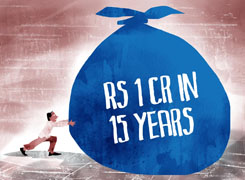I want to invest 25 lakhs rupees for lumpsum in mutual fund please suggest me the name of mutual fund
Ans: Investing a large sum like Rs 25 lakhs requires a strategic approach. Mutual funds are a popular choice due to their diversification, professional management, and potential for wealth creation. As a Certified Financial Planner, my aim is to guide you in making informed decisions.
Below, I provide a detailed analysis and steps to consider before selecting the right mutual funds for your investment.
Understand Your Financial Goals
Before investing, it's essential to define your financial goals.
Time Horizon: Determine how long you plan to invest. Is this a short-term, medium-term, or long-term investment?
Risk Tolerance: Evaluate your risk appetite. Are you comfortable with market volatility, or do you prefer stable returns?
Financial Objectives: Identify the purpose of this investment. Are you saving for retirement, a child's education, or a major purchase?
These factors will guide your selection of mutual funds that align with your goals.
Diversification: The Key to Managing Risk
Investing in mutual funds allows for diversification across various asset classes.
Equity Funds: These are suitable if you have a high-risk appetite and a long-term horizon. They invest in stocks and have the potential for high returns.
Debt Funds: Ideal for conservative investors, these funds focus on bonds and fixed-income securities. They provide stability and are less volatile.
Hybrid Funds: If you're looking for a balanced approach, hybrid funds combine equity and debt. They offer a mix of growth and stability.
International Funds: For diversification across global markets, international funds are an option. However, they carry currency and geopolitical risks.
Diversifying across these categories can help manage risk and optimize returns.
The Importance of Fund Selection
While specific fund names are not recommended here, the criteria for selecting the right mutual funds are critical.
Fund Performance: Look at the fund's historical performance over different market cycles. Consistency in returns is a good indicator.
Fund Manager's Track Record: The experience and track record of the fund manager play a significant role in the fund's performance. A seasoned manager with a good track record can add value to the fund.
Expense Ratio: This is the annual fee charged by the fund for managing your investment. A lower expense ratio means more of your money is invested in the market.
Fund House Reputation: Choose funds from reputable fund houses with a strong history of managing investors' money.
Portfolio Composition: Review the underlying assets in the fund's portfolio. Ensure they align with your risk tolerance and investment objectives.
Disadvantages of Index Funds and Direct Plans
You might encounter options like index funds or direct plans. However, there are specific drawbacks to consider:
Index Funds: These funds replicate a market index and are passively managed. While they offer low fees, they lack flexibility. Actively managed funds have the potential to outperform the market, as fund managers can take advantage of market opportunities.
Direct Plans: Direct plans may seem attractive due to lower fees. However, they come without professional guidance. Investing through a Mutual Fund Distributor (MFD) with CFP credentials ensures you receive expert advice, personalized planning, and ongoing support.
Creating a Tailored Portfolio
To maximize the potential of your Rs 25 lakh investment, consider building a diversified portfolio:
Large-Cap Funds: These funds invest in well-established companies with strong market capitalizations. They offer stability and moderate growth.
Mid-Cap Funds: For higher growth potential, mid-cap funds invest in medium-sized companies. They are riskier than large-cap funds but can deliver significant returns over time.
Small-Cap Funds: These funds target smaller companies with high growth potential. They are the most volatile but can offer substantial returns if chosen wisely.
Sectoral/Thematic Funds: If you have a strong belief in a particular sector (e.g., technology, healthcare), you might allocate a small portion of your investment to sectoral or thematic funds. These funds are riskier and should only be a small part of your portfolio.
Debt and Hybrid Funds: To balance your portfolio, allocate a portion to debt and hybrid funds. This provides stability and reduces overall risk.
Rebalancing and Monitoring
Investing is not a one-time activity. Regularly monitoring and rebalancing your portfolio ensures it stays aligned with your goals.
Annual Review: Review your portfolio at least once a year. Assess the performance and make adjustments if needed.
Rebalancing: If one asset class outperforms or underperforms, rebalance your portfolio to maintain your desired asset allocation.
Stay Updated: Keep yourself informed about market trends and economic changes. This will help you make timely decisions.
Tax Implications and Exit Strategy
Understanding the tax implications of your investment is crucial. Mutual fund investments are subject to capital gains tax:
Equity Funds: Short-term capital gains (held for less than one year) are taxed at 20%, while long-term capital gains (held for more than one year) exceeding Rs 1.25 lakh are taxed at 12.5% without indexation.
Debt Funds: Gains are taxed as per your income tax slab.
Plan your exit strategy based on these tax considerations to optimize your post-tax returns.
Aligning with Your Financial Plan
Your Rs 25 lakh investment should align with your overall financial plan.
Emergency Fund: Ensure you have an adequate emergency fund in place before investing. This should cover 6-12 months of living expenses.
Insurance Coverage: Verify that you have sufficient life and health insurance. This protects your investment and your family.
Debt Management: If you have any high-interest debt, consider paying it off before making large investments. Reducing debt can free up more funds for future investments.
Professional Guidance and Final Insights
Investing in mutual funds can be complex, especially with a significant amount like Rs 25 lakhs. Seeking professional guidance ensures that your investment strategy is well-structured and aligned with your financial goals.
Remember, the key to successful investing is a well-thought-out plan, disciplined execution, and regular monitoring.
Finally, stay committed to your investment plan, avoid impulsive decisions based on market fluctuations, and focus on your long-term objectives.
Best Regards,
K. Ramalingam, MBA, CFP,
Chief Financial Planner,
www.holisticinvestment.in


























